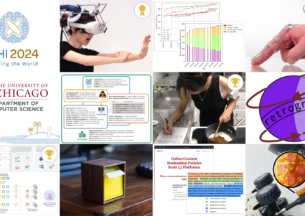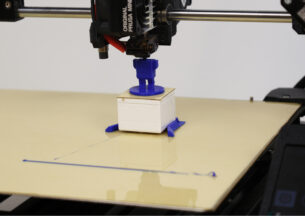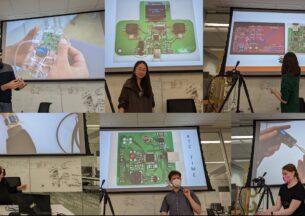UChicago CS Researchers Create Living Smartwatch to Explore Human-Device Relations
Devices such as phones, laptops, and smartwatches are constant companions for most people, spending days and nights in their pocket, on their wrist, or otherwise close at hand. But when these technologies break down or a newer model hits stores, many are quick to toss out or replace their device without a second thought. This disposability leads to rising levels of electronic waste – the fastest-growing category of waste, with 40 million tons generated each year.
 PhD student Jasmine Lu and Assistant Professor of Computer Science Pedro Lopes wondered if they could change that fickle relationship by bringing devices to life – literally. Using the electrically-conductive single-cell organism known as “slime mold,” the researchers created a watch that only works when the organism is healthy, requiring the user to provide it with food and care. They then tested how this living device affected its wearer’s attitude towards technology, changing the usual one-way service into a mutually beneficial partnership.
PhD student Jasmine Lu and Assistant Professor of Computer Science Pedro Lopes wondered if they could change that fickle relationship by bringing devices to life – literally. Using the electrically-conductive single-cell organism known as “slime mold,” the researchers created a watch that only works when the organism is healthy, requiring the user to provide it with food and care. They then tested how this living device affected its wearer’s attitude towards technology, changing the usual one-way service into a mutually beneficial partnership.
“People were forced to think about their relationship to devices in a lot of really interesting ways,” said Lu, a 4th-year graduate student in Lopes’ Human-Computer Integration Lab. “When discussing their experiences with normal smartwatches, Fitbits, or other wearable devices, people said they just used it for an explicit purpose. And with this device, it felt more like a bi-directional relationship because they had to care for it. They also had some sort of attachment to it because it’s living, and they felt like they couldn’t throw it away, or just put it in the closet.”
The watches were designed and built by Lu to tell time and measure the wearer’s heart rate. However, the second function is dependent upon the health and unique characteristics of Physarum Polycephalum, a species of slime mold sometimes called “the blob,” for its rapid growth, resilience, and curious maze-solving abilities.
The organism is placed in an enclosure on the watch, and the user must regularly feed it a mixture of water and oats to induce its growth. When the slime mold reaches the other side of the enclosure, it forms an electrical circuit that activates the heart rate monitor function. The organism can also enter a dormant state when not fed, allowing for revival days, months, or even years later.
“A lot of HCI research is motivated by making things easier to use and faster to use,” Lopes said. “But Jasmine thought there should be more friction; you should have to care for it and feed it every day, for the sake of just having to reflect on it. So it’s like half art piece and half research paper.”
Once the watches were built, Lu and Lopes conducted a study with five participants who wore the watch for two weeks. Over the first week, the users cared for the slime mold until the heart rate monitoring was enabled. Then for the second week, the researchers asked participants to stop feeding the organism, causing it to dry out and disrupt the heart rate function. Throughout the study, participants journaled their feelings about the device and answered interview questions.

The researchers found a high level of attachment to the watch, with some users saying it felt like a pet – even naming it, or putting their partner in charge of the feeding when they fell ill. Subjects said that the connection was more meaningful than with virtual pets such as Tamagotchis or The Sims, which can be casually reset after death. Even more surprising was the emotional response when study participants were told to neglect the organism, expressing guilt or even grief.
“People were shocked; almost all of them were like, ‘really? I have to do that?’,” Lopes said. “There were very human responses. Some people were sad, some people really felt like the connection was broken. Some people even said that, after one or two days, they went back to how they treat their normal devices, completely one-directional. It was really cool to see that.”
Lu presented the paper, and a demonstration of the watch, at the 2022 ACM Symposium on User Interface Software and Technology (UIST), one of the top human-computer interaction (HCI) conferences. Her hope is that the research won’t just inspire creative new devices that run on slime mold power, but also provoke designers to create technologies that inspire attachment and mutual benefit, to make devices feel less like disposable tools and more like partners.
“With our devices, we can engage in a lot of different forms of care, like cleaning and taking care of them, or repairing them when they’re broken,” Lu said. “But a lot of the ways that consumer devices are designed now, those aspects of care are less focused on or are made inaccessible; they are made so that you trash them, instead of engaging with them more. So I definitely think there is a design takeaway of focusing on this aspect of caring for devices instead of just consuming them.”













